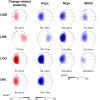Sustained posterior contralateral activity indicates re-entrant target processing in visual change detection: an EEG study
- PMID: 24860467
- PMCID: PMC4017132
- DOI: 10.3389/fnhum.2014.00247
Sustained posterior contralateral activity indicates re-entrant target processing in visual change detection: an EEG study
Abstract
The present study investigated the neural mechanisms that contribute to the detection of visual feature changes between stimulus displays by means of event-related lateralizations of the electroencephalogram (EEG). Participants were instructed to respond to a luminance change in either of two lateralized stimuli that could randomly occur alone or together with an irrelevant orientation change of the same or contralateral stimulus. Task performance based on response times and accuracy was decreased compared to the remaining stimulus conditions when relevant and irrelevant feature changes were presented contralateral to each other (contralateral distractor condition). The sensory response to the feature changes was reflected in a posterior contralateral positivity at around 100 ms after change presentation and a posterior contralateral negativity in the N1 time window (N1pc). N2pc reflected a subsequent attentional bias in favor of the relevant luminance change. The continuation of the sustained posterior contralateral negativity (SPCN) following N2pc covaried with response times within feature change conditions and revealed a posterior topography comparable to the earlier components associated with sensory and attentional mechanisms. Therefore, this component might reflect the re-processing of information based on sustained short-term memory representations in the visual system until a stable target percept is created that can serve as the perceptual basis for response selection and the initiation of goal-directed behavior.
Keywords: N2pc; SPCN; attention; perception; re-entrant processing; short-term memory.
Figures






Similar articles
-
Dissociation of the N2pc and sustained posterior contralateral negativity in a choice response task.Brain Res. 2008 Jun 18;1215:160-72. doi: 10.1016/j.brainres.2008.03.059. Epub 2008 Apr 7. Brain Res. 2008. PMID: 18482718
-
Mechanisms of target localization in visual change detection: an interplay of gating and filtering.Behav Brain Res. 2013 Nov 1;256:311-9. doi: 10.1016/j.bbr.2013.08.046. Epub 2013 Aug 31. Behav Brain Res. 2013. PMID: 24001756
-
Time-course of hemispheric preference for processing contralateral relevant shapes: P1pc, N1pc, N2pc, N3pc.Adv Cogn Psychol. 2012;8(1):19-28. doi: 10.2478/v10053-008-0098-9. Epub 2012 Feb 3. Adv Cogn Psychol. 2012. PMID: 22419963 Free PMC article.
-
Express attentional re-engagement but delayed entry into consciousness following invalid spatial cues in visual search.PLoS One. 2008;3(12):e3967. doi: 10.1371/journal.pone.0003967. Epub 2008 Dec 17. PLoS One. 2008. PMID: 19088847 Free PMC article. Clinical Trial.
-
Electrophysiological Advances on Multiple Object Processing in Aging.Front Aging Neurosci. 2016 Mar 2;8:46. doi: 10.3389/fnagi.2016.00046. eCollection 2016. Front Aging Neurosci. 2016. PMID: 26973520 Free PMC article. Review.
Cited by
-
The Psychophysiology of Action: A Multidisciplinary Endeavor for Integrating Action and Cognition.Front Psychol. 2018 Aug 29;9:1423. doi: 10.3389/fpsyg.2018.01423. eCollection 2018. Front Psychol. 2018. PMID: 30210379 Free PMC article.
-
Did you even see that? visual sensory processing of single stimuli under different locomotor loads.PLoS One. 2022 May 26;17(5):e0267896. doi: 10.1371/journal.pone.0267896. eCollection 2022. PLoS One. 2022. PMID: 35617315 Free PMC article.
-
From Capture to Inhibition: How does Irrelevant Information Influence Visual Search? Evidence from a Spatial Cuing Paradigm.Front Hum Neurosci. 2016 May 20;10:232. doi: 10.3389/fnhum.2016.00232. eCollection 2016. Front Hum Neurosci. 2016. PMID: 27242493 Free PMC article.
-
Camouflage patterning modulates neural signatures of attention and decision-making.Proc Biol Sci. 2024 Aug;291(2028):20240865. doi: 10.1098/rspb.2024.0865. Epub 2024 Aug 14. Proc Biol Sci. 2024. PMID: 39137890 Free PMC article.
References
LinkOut - more resources
Full Text Sources
Other Literature Sources

